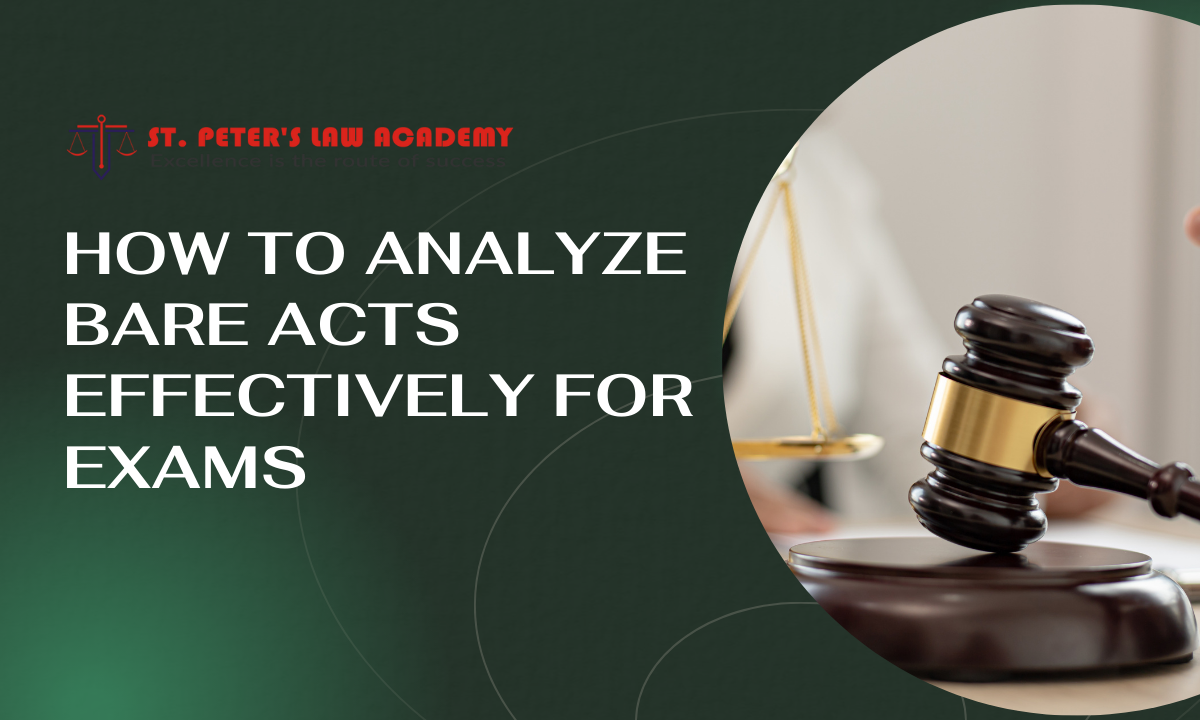+91 9990898327
Office : 632, Dr. Mukherjee Nagar, Delhi 110009
Mon-Sun: 09:00AM - 08:00PM

How to Analyze Bare Acts Effectively for Exams
When preparing for judiciary or law-based competitive examinations, one of the most essential tools you will be using is the Bare Act. A Bare Act is the unadulterated text of a particular legislation made up of all the sections, clauses, and provisions without any added commentary. It is the untainted essence of the law and is the basis of legal interpretation and understanding.
However, reading Bare Act is intimidating due to the jargon and technical terms. In order to obtain maximum benefit out of these very important documents, a step-by-step tutorial of how to efficiently analyze Bare Acts for exams follows.

Prior to reading the sections, start off by finding the purpose of the Act. The long title and the preamble (if any) provide you with a sense object of the purpose of the Act. Being aware of the purpose helps you place the provisions in perspective, identify the legislative intent, and anticipate how sections relate to one another.
For instance, a law that seeks to regulate criminal proceedings will be of an entirely different nature and structure than one that seeks to regulate civil disputes. This general knowledge sets the tone for subsequent learning.
A Bare Act is typically made up of Parts, Chapters, Sections, Sub-sections, Clauses, and sometimes Schedules. Knowing this structure is essential:
By understanding this hierarchy, you can effectively compartmentalize information and learn more systematically.
Almost all Acts are prefaced by a section explaining key terms used in the legislation. These definitions are significant because they may be distinct from their normal meanings.
Never assume you know what a legal term is unless you've checked out how the Act defines it. For example, a term like "court" or "document" might have a particular meaning depending on the Act. Always refer back to the definition section if you come across a term you're not familiar with.
The Bare Act language is formal, brief, and sometimes ambiguous. To make sense of it:
Identify important keywords: Keywords including shall, may, and, or, subject to, and notwithstanding play serious legal interpretation roles. For example, shall describes an obligation to do something while may is more often an option.
The interpretations of these words enable understanding the legislative intent as well as prepping questions pursuant to interpretation.
Try to connect sections to legal situations or past cases you read. For example, while reading about the right to constitutional remedies, think about famous writ petitions and how the court used specific articles.
This approach is useful in two ways:
Recreating mind maps, flowcharts, or tables enables you to understand the organization of the Act and the continuity of one section with the other. Jotting down a few words beside each section which describe the essence in your own words makes revision easy.
For instance, in a law of procedure, you can sketch a simple flowchart of procedures starting from suing to its being disposed of, with corresponding section numbers. These charts and graphs are found to be extremely helpful while doing last-minute revisions.
Reading is not enough, you must be able to recall what you’ve read without looking. After studying a section, close the book and try to recall the section’s number, content, and keywords.
Use flashcards or spaced repetition tools to quiz yourself at regular intervals. This method cements your learning and ensures long-term retention.
Some Acts contain numerous sections which need to be memorized sequentially. Preparing mnemonics or memory hooks can help.
For example, to remember the six freedoms provided under Article 19 of the Indian Constitution, create a sentence where each word represents one freedom. This method comes very much in handy during exams when simple questions relating to "which section provides what" are common.
After familiarizing yourself with a Bare Act, start trying judiciary papers of previous years with the Act laid open alongside. You will then:
Clarifying a provision to another person or engaging in discussion with others makes you clarify your understanding. Instruction helps you identify the gaps in your understanding and consolidate what you already understand.
This approach also provides you with exposure to varied viewpoints and meanings of the same part, which is useful in answer writing for exams.
Legal memory tends to deteriorate. Keep revising important Acts and sections from time to time. Even revising Bare Acts for a mere 10 minutes daily can significantly enhance recall and confidence.
Prepare revision timetables at weekly or monthly intervals to review Acts you have already read, although even briefly, so that they stay fresh in your mind.

Consult with your teachers, or mentors for clarification.
Bare Act study is not about reciting portions; it's understanding the law in its bare form. On systematic reading, Bare Acts give coherence, conciseness, and illumination of legal reasoning. For those who want to try the judiciary exams, Bare Act mastery is not just helpful, it is essential.
Post a comment